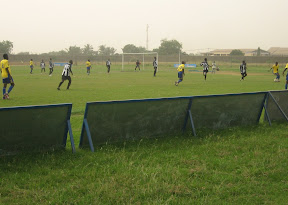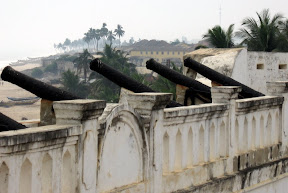
Jessica and I took a series of uncomfortable tro tros to the town of Boti where we saw the falls (or trickles), caves, umbrella rock, and a palm tree with three trunks. We were told that a guide was necessary since we couldn’t find our way on our own. After a moment’s hesitation (half fear, half scepticism) we departed with our not-so-informative new friend. We got to the caves after a slightly scary descent. The caves were less climbing through narrow spaces than I expected and more rock worn away on the mountainside. We got the dwarf story again, surprisingly with most of the same details (see Mommy in Ghana post). Trying to be quiet so we didn’t get eaten, we scaled the other side of the valley to the umbrella rock. Another reminder of how out of shape I am (which I’m trying to do something about now, but I don’t want to jinx it … too late?). Personally, I think it was more of a mushroom rock, but what do I know. We weren’t adventurous enough to climb the makeshift ladder to the top for a small fee. The spot provided more views that would be more impressive if it weren’t for the Harmattan. The palm tree looked like a pitchfork with another sketchy ladder for picture opps. Back across the field, down & up the valley, through the town, and down 250 steps (yeah stairs!) we made it to the falls. The dry season stole most of the water, leaving two trickles (one male, one female because every pair must be a heterosexual couple) and a stagnant pool. It allowed us to get really close to the impressive drop and climb around. We opted to head straight back to Accra since a car was about to leave. Later we learned that we missed a NPP (opposition party) rally and big football match. Sigh, another time.
You’re probably all wondering about the crazy coffins by now. In this one neighbourhood wood carvers make coffins into pretty much any shape requested. I believe the tradition came from the animists (but don’t quote me on that, please). There are about five shops where they do the custom designs with a showroom on the top floor. Most pieces seemed oddly small; when I enquired a grumpy man told me they were for exhibition only. Apparently they make full-sized coffins for orders (we saw a recreation of Elmina castle, a village hut, a fishing boat) and smaller ones for display (pineapple, crab, sankofa, and my personal favourites an Air Canada plane and a cigarette). Seems morbid, I know, but there were no dead bodies and an afternoon at the beach easily ridded my mind of anything bad.
On Saturday Joanne, Jessica, and I traveled towards Akosombo to an area that is know for its beads. Our first stop was the very impressive Cedi Bead Factory. The grounds were clean with shelters for each of the activities and nicely painted buildings. One of the workers gave us a detailed explanation of how the beads were made. He even had props to demonstrate the different techniques. It was a great tour and we (and the staff) were happy with our purchases. Many women buy the imperfect bead and sell them at a nearby market. It was great to walk around and see even more variety of beads, material, food stuffs (not so enjoyable when we got stuck in the dried fish section), and pottery.

On Sunday Jessica and I headed to Tema, a neighbouring industrial town, to watch a football match. The website, newspaper, and several people we asked said that two Ghana Football League teams were playing so we arrived early to get good spots. Turns out, they played yesterday or will next weekend, or something, so we settled in to see the Ho Home Stars versus a team that looked like they worked at Footlocker. The whole thing was rather comical. We were two of about 15 people there and definitely the only females, white people, and ones sitting in plastic chairs that were brought to us. The stadium had surprisingly green grass with a metal fence a few metres off the field and a cement wall protecting it from the outside world. The spectators get the joy standing between the two fences. I think I understand how hundreds got tramples when fans were locked in at a popular game. The Home Stars had cheerleaders that seemed like a cultural performance (costumes, drums, rattles, singing). Even I could tell the teams weren’t too great. Every few minutes a player would fall to the ground, grabbing his foot/knee/face. If he stayed down for more than 15 seconds, three guys would come running out with a stretcher. If he got up they would veer back with the same little trot that they started out with. It reminded me of a clown routine. You know, all the clowns get out of the car and run around, then one slips and falls and the clown ambulance comes roaring out … anyone?




